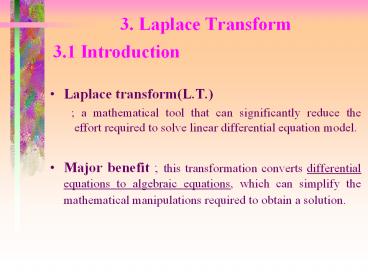3. Laplace Transform PowerPoint PPT Presentation
1 / 18
Title: 3. Laplace Transform
1
3. Laplace Transform
3.1 Introduction
- Laplace transform(L.T.)
- a mathematical tool that can significantly
reduce the effort required to solve linear
differential equation model. - Major benefit this transformation converts
differential equations to algebraic equations,
which can simplify the mathematical manipulations
required to obtain a solution.
2
3.2 Laplace Transform of Representative Functions
- Definition
- Where the function f(t) must satisfy conditions
which include being piecewise continuous for
. - Inverse transform
- Property Linear operator it satisfies the
general superposition principle.
3
- Examples
- 1. Constant function
- , ( is a constant)
- 2. Unit step function
4
- Delta function (the first derivative of the step
function)
5
- 3. Derivatives
- n-th order derivative
- where is the i-th derivative
evaluated at t0.
6
- 4. Exponential function
- if blt0, the real part of s must be restricted to
be larger than -b for the integrated to be
finite. - 5. Trigonometric functions
- Euler Identity
7
- 6. Rectangular pulse function
Figure 3.1. The rectangular pulse function.
8
3.3 Solution of Differential Equations by
Laplace Transform Techniques
- Example Solve the differential equation,
- using Laplace transform.
- Solution) Take Laplace transform both side of
(3.19).
9
- General solution procedure
- 1. Take the Laplace transform of both sides of
the differential equation. - 2. Solve for .
- If the expression for dose not appear in
table. - If the expression for not appear in
table, go to Step 5. - 3. Factor the characteristic equation polynomial.
- 4. Perform the Partial Fraction Expansion.
- 5. Use the inverse Laplace transform relations to
find y(t).
10
3.4 Partial Fraction Expansion
- Example) Consider
- How to find and .
- Method 1.
- Multiply both sides of (3.24) by
. - Equating coefficients of each power of s, we have
- Solving for and simultaneously. ?
, .
11
- Method 2. Since (3.24) should hold for all
values of s, we can specify two values of s and
solve for the two constant. - Solving, .
- Method 3. Heaviside expansion
- The fastest and most popular method.
- We multiply both sides of the equation by one of
the denominator terms - and then set , which causes all
terms except one to be multiplied by zero.
12
- Heaviside Expansion
- - General form
- Case 1) If all are distinct.
- Case 2) Repeated Factors If a denominator term
occur times in
the denominator, terms must be included in
the - expansion that incorporate the factor
- in addition to the other factors.
13
- How to Find for repeated factor case.
- Example
- For
- set up the partial fractions and evaluate their
coefficient. - Approach 1
- Substituting the value in (3.34)
yields
14
- Approach 2 Differentiation of the transform.
- Multiply both sides of (3.34).
- Then (3.39) is differentiated twice with respect
to , - , so that
. - Differentiation approach
- If the denominator polynomial contains
the repeated factor - , first form the quantity.
- The general expression for is given as follows
15
- Case 3) Complex Factors
- Apply Inverse Laplace transform (3.43).
- With the use of the identities,
- (3.44) becomes
16
3.5 Other Laplace Transform Properties
- Final value theorem
- If exits,
- Proof) Use the relation for the Laplace transform
of a derivative. - Taking the limit as and assuming that
is continuous and has a limit for
all , we find - Integrating the left side and simplifying yields
17
- Initial value theorem
- In the analogy to the final value theorem,
initial value theorem can be stated as - Proof) The proof of this theorem is similar to
the case of the final value theorem. - Transform of an integral
18
- Time Delay(Translation in Time)
- Time delays are commonly encountered in process
control problems because of the transport time
required for a fluid to flow through piping.
Figure 3.2. A time function with and without time
delay. (a) Original function(no delay) (b)
Function with delay.

